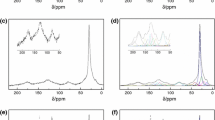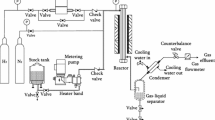Abstract
Sulfur plays an important role in the generation and evolution of hydrocarbon from organic matter. Here, a pyrolysis experiment in closed system was performed on Maoming oil shales kerogen (Type I), Maoming oil shales kerogen added with sulfur ether and Maoming oil shales kerogen added with sulphur. The results suggest that the existence of sulfur can result in: (i) higher yield of hydrocarbons generated from the kerogen; (ii) decrease of the temperature for the maximum generation of heavy hydrocarbons (the C15+ fraction) by 20°C; (iii) decrease of the temperature for the maximum generation of the aromatics fraction by 40°C, and (iv) acceleration of the aromatization process. The pyrolysates from kerogen added with sulfur are similar to the heating products of the sulfur-rich kerogen as reported in the literatures. It seems that the sulfur catalysis is also an important factor that can make the sulfur-rich kerogen generate low-mature oil at the earlier diagenesis stage, except for the weakness of the C-S and S-S bonds.
Similar content being viewed by others
References
Damste, J. S. S., De Leeuw, J. W., Analysis structure and geochemical significance of organically-bound sulphur in the geosphere: State of the art and future research, in Advances in Organic Geochemistry 1989 (eds. Durand, B., Behar, F.), Organic Geochemistry, 1990, 16: 1077–1101.
Damste, J. S. S., Eglinton, T. I., De Leeuw, J. W. et al., Organic sulphur in macromolecular sedimentary organic matter: I. Structure and origin of sulphur-containing moieties in kerogen, asphaltene and coal as revealed by flash pyrolysis, Geochimica et Cosmochimica Acta, 1989, 53: 873–889.
van Dongen, B. E., Schouten, S., Baas, M. et al., An experimental study of the low-temperature sulfurization of carbohydrates, Organic Geochemistry, 2003, 34(8): 1129–1144.
Marika, D. K., Schouten, S., Sinninghe Damsté, J. S., Formation of insoluble, nonhydrolyzable, sulfur-rich macromolecules via incorporation of inorganic sulfur species into algal carbohydrates, Geochimica et Cosmochimica Acta, 2000, 64(15): 2689–2699.
Gelin, F., Marika, D. K., de Leeuw, J. W. et al., Laboratory sulfurisation of the marine microalgaNannochloropsis salina, Organic Geochemistry, 1998, 29(8): 1837–1848.
Xia Yanqing, Meng Qianxiang, Wang Hongyong et al., The simulation of the formation of benzothiophene series compounds and their significance, Acta Sedimentologica Sinica (in Chinese), 1999, 17(1): 127–129.
Xia Yanqing, Wang Chunjiang, Meng Qianxiang et al., Investigation of mechanisms of formation of biphenyls and benzonaph-thothiophenes by simulation experiment, Sciences in China (in Chinese), 1999, 29(3): 257–262.
Xia Yanqing, Wang Chunjiang, Meng Qianxiang et al., The simulation on the mechanism of formation of thiophene series compounds, Geochimica (in Chinese), 1999, 28(4): 393–396.
Fu Jiamo, Sheng Guoying, Jiang Jigang, Immature crude oil from hypersaline environmental deposition, Oil & Gases (in Chinese), 1986, 6(2): 150–158.
Jiang Jigang, Sheng Guoying, Fu Jiamo, The discovery of high sulfur immature crude oil in salt lake basin, Experiments for Oil and Gas (in Chinese), 1988, 10(4): 337–342.
Peng Pingan, Fu Jiamo, Sheng Guoying et al., Geochemical characteristics of supergene organic matter in hypersaline environment, Sciences in China (in Chinese), Ser. B, 1989(1): 84–92.
Peng Pingan, Sheng Guoying, Fu Jiamo et al., Origin of immature sulfur-rich oil in Jianghan oil field, Chinese Science Bulletin (in Chinese), 1998, 43(6): 636–638.
Peng Ping’an, Sheng Guoying, Fu Jiamo et al., Immature crude oils in the salt lake depositional environment are related to organic matter precipitated at stage of carbonate in salt lake sedimentation sequences, Chinese Science Bulletin (in Chinese), 2000, 45 (Supplement): 2689–2694.
Wang Tieguan, Zhong Ningning, Hou Dujie et al., Genetic mechanism and occurrence of immature oil and gas (in Chinese), Beijing: Petroleum Industry Press, 1995.
Wang Tieguan, Zhong Ningning, Hou Dujie et al., Several genetic mechanisms of immature crude oils in China, Acta Sedimentologica Sinica, 1997, 15(2): 75–83.
Zhang Linye, Zhang Shouchun, Huang Kaiquan et al., Simulation experiment of immature oil genetic mechanism in lake facies of semi-salt water, Chinese Science Bulletin (in Chinese), 1999, 44(4): 361–368.
Qin Kuangzong, Guo Shaohui, Lishuyuan, Structure of organic geological macromolecules and generation of immature oil, Petroleum Exploration and Development, 1997, 24(5): 1–6.
Hold, I. M., Brussee, N. J., Schouten, S. et al., Changes in the molecular structure of a Type II-S kerogen (Monterey Formation, U.S.A.) during sequential chemical degradation, Organic Geochemistry, 1998, 29: 1403–1417.
Lewan, M. D., Ruble, T. E., Comparison of petroleum generation kinetics by isothermal hydrous and nonisothermal open-system pyrolysis, Organic Geochemistry, 2002, 33(12): 1457–1475.
Putschew, A., Schaeffer-Reiss, C., Schaeffer, P. et al., Release of sulfur- and oxygen-bound components from a sulfur-rich kerogen during simulated maturation by hydrous pyrolysis, Organic Geochemistry, 1998, 29(8): 1875–1890.
Tannenbaum, E., Aizenshtat, Z., Formation of immature asphalt from organic-rich carbonate rocks-I. Geochemical correlation, Organic Geochemistry, 1985, 8: 181–192.
Baskin, D. K., Peters, K. E., Early generation characteristics of a sulfur-rich Monterey Kerogen, The American Association of Petroleum Geologists Bulletin, 1992, 76(1): 1–13.
Orr, W. L., Kerogen/asphaltene/sulfur relationships in sulfur-rich Monterey oils, Organic Geochemistry, 1986, 10: 499–516.
Bazhenova, O. K., Arefiev, O. A., Immature oils as the products of early catagenetic transformation of bacterial-algal organic matter, Organic Geochemistry, 1990, 16(1-3): 307–311.
Lewan, M. D., Sulphur-radical control on petroleum formation rates, Nature, 1998, 391: 164–166.
Fu Jiamo, Xu Yufen, Chen Deyu et al., Biomarker compounds of biological inputs in Maoming oil shale, Geochemistry (in Chinese), 1985, (2): 99–114.
Radke, M., Welte, D. H., Willsch, H., Geochemical study on a well in the Western Canada Basin: relation of the aromatic distribution pattern to maturity of organic matter, Geochimica et Cosmochimica Acta, 1982, 46(1): 1–10.
Ronald, J. H., Tang, Y. C., Kaplan, I. R., Insights into oil cracking based on laboratory experiments, Organic Geochemistry, 2003, 34(12): 1651–1672.
Tomic, J., Behar, F., Vandenbroucke, M. et al., Artificial maturation of Monterey kerogen (Type II-S) in a closed system and comparison with Type II kerogen: Implications on the fate of sulfur, Organic Geochemistry, 1995, 23(7): 647–660.
Author information
Authors and Affiliations
Corresponding author
About this article
Cite this article
Yan, Q., Peng, P., Yu, C. et al. The role of sulfur in the pyrolysis of kerogen. Chin. Sci. Bull. 49 (Suppl 1), 10–18 (2004). https://doi.org/10.1007/BF02890448
Received:
Revised:
Issue Date:
DOI: https://doi.org/10.1007/BF02890448




